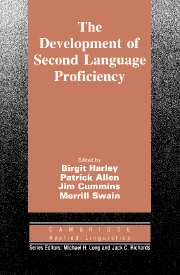Book contents
- Frontmatter
- Contents
- List of contributors
- Series editors' preface
- Acknowledgments
- Introduction
- I THE NATURE OF LANGUAGE PROFICIENCY
- II CLASSROOM TREATMENT
- Chapter 5 Aspects of classroom treatment: toward a more comprehensive view of second language education
- Chapter 6 Process-product research on second language learning in classrooms
- Chapter 7 Analysis and experience as variables in second language pedagogy
- Chapter 8 Response by DBP project members to the discussion papers of Patsy Lightbown and H.H. (David) Stern
- III SOCIAL AND INDIVIDUAL VARIABLES
- IV PRACTICAL AND POLICY IMPLICATIONS
- V THIRTY-FIVE YEARS OF RESEARCH ON BILINGUALISM
- CONCLUSION
- References
- Author Index
- Subject Index
Chapter 6 - Process-product research on second language learning in classrooms
Published online by Cambridge University Press: 05 October 2012
- Frontmatter
- Contents
- List of contributors
- Series editors' preface
- Acknowledgments
- Introduction
- I THE NATURE OF LANGUAGE PROFICIENCY
- II CLASSROOM TREATMENT
- Chapter 5 Aspects of classroom treatment: toward a more comprehensive view of second language education
- Chapter 6 Process-product research on second language learning in classrooms
- Chapter 7 Analysis and experience as variables in second language pedagogy
- Chapter 8 Response by DBP project members to the discussion papers of Patsy Lightbown and H.H. (David) Stern
- III SOCIAL AND INDIVIDUAL VARIABLES
- IV PRACTICAL AND POLICY IMPLICATIONS
- V THIRTY-FIVE YEARS OF RESEARCH ON BILINGUALISM
- CONCLUSION
- References
- Author Index
- Subject Index
Summary
Doing research on how instructional variation affects learning in classroom settings is one of the most frustrating endeavors known. When the classroom setting is one in which a second language is being taught and learned, the researcher is immediately faced with a major theoretical problem: There is little agreement among theorists about the relationship between the actual samples of the language that learners are exposed to (whether in or out of classrooms) and the rules and systems that eventually characterize their knowledge of the language (see White 1985b). Beyond this very fundamental theoretical controversy, all the uncertainty associated with educational research must be added: the impossibility of identifying comparable control groups or ensuring random selection for treatment groups; the influence of unmeasured variables such as momentary motivation and attendveness; the problem of knowing what happens in the classroom environment when no observer is present; the fact that in second language situations, learning continues outside the classroom.
Some classroom-centered research is done by the blissfully uninformed. The researcher carefully counts the occurrences of some seemingly interesting phenomenon in one teacher's speech or behavior and compares it to that of another teacher and confidently infers that any differences in student performance are related to these observed teacher behaviors. Indeed, some researchers do not even go so far as the second step (correlating some instructional difference with differences in outcome). They go directly from observation to recommendation, having concluded in advance that more (or less) error correction, more (or less) simplified syntax, more (or fewer) information questions facilitate learning.
- Type
- Chapter
- Information
- The Development of Second Language Proficiency , pp. 82 - 92Publisher: Cambridge University PressPrint publication year: 1990
- 3
- Cited by



